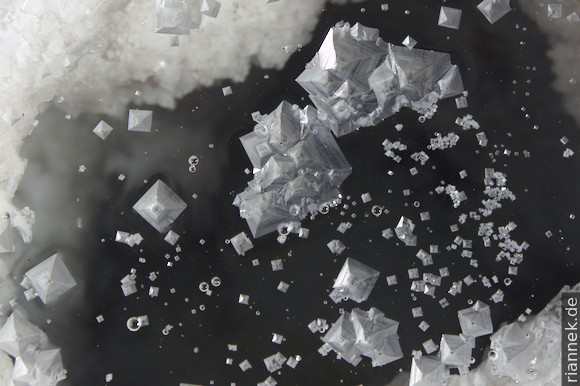
When saline water is evaporated — by humans in saltworks to extract sea salt or naturally at salt lakes and salars — to the point that it is saturated or supersaturated in NaCl (halite, common salt) and possibly other salts, it precipitates in the form of solid crystals. Normally, halite crystals are cube-shaped and they are naturally heavier than the salt water and are thus at the bottom (although larger cubes are the exception).
Nevertheless, crystals floating on the water surface or small “salt rafts” can sometimes be seen. This phenomenon occurs when evaporation is particularly strong and no wind sinks the bowl-shaped crystals again. In this case, the salt concentration directly on the water surface is particularly high and nucleation of salt crystals occurs preferentially at the interface of salt water and air.
A supersaturated solution is not in a chemical equilibrium. It contains more of the substance in question (e.g. salt) than can actually be dissolved in the solvent (e.g. water) under appropriate conditions (especially temperature). This is only possible if for some reason the nucleation of crystals does not take place or is delayed. As soon as nucleation starts, so much of the substance crystallises very quickly until the chemical equilibrium is restored and the solution is exactly saturated.
This is exactly what can happen on the surface of salt water. Due to the particularly strong supersaturation, however, no normal cube-shaped crystals grow, but “boats” in the shape of a pyramid with the tip pointing downwards. The original nucleus of the crystal is located in the tip of the pyramid. This kind of crystals is called hopper crystals.
As I said, at first glance these crystals consist of four faces of a pyramid. If you look more closely, however, you will see that these faces actually consist of small steps. The faces of these steps correspond crystallographically to the cube faces. During the very rapid growth from the highly supersaturated solution, new ions do not accumulate evenly on a cube face (which would produce a normal cube-shaped crystal), but preferentially near the edges. A step thus forms along the edge.
By the way, the exact opposite happens during slow growth, because the accumulation in front of a step is energetically most favourable. This leads to the disappearance of a step on the crystal surface, which thus remains almost a flat surface even on an atomic scale during crystal growth. During the rapid growth of a hopper crystal, the “building up” of the crystal with ions takes place at an energetically unfavourable position, simply because the supply with further ions is faster there. The (electrically charged) ions of the edge can attract matching (oppositely charged) ions better than the ions of a surface.
The result is that the tiny seed crystal grows into a hopper crystal which, thanks to its bowl shape, displaces so much water that it floats and thus remains where the ideal growth conditions prevail. Over time, many of these crystals can grow together to form a “raft”. Sometimes (e.g. in windy conditions), however, they sink and continue to grow on the bottom (and possibly into normal cubes).
Because the hopper crystals are nicely “crunchy” compared to normal salt, they are considered a delicacy in some countries. In the case of fleur de sel (“salt flower”) from France, these are hopper crystals that are collected by hand in saltworks.
The picture above shows floating hopper crystals in a small saltwater hole of a salar in Argentina called Salinas Grandes del Noroeste.
Incidentally, a similar phenomenon sometimes occurs during crystallisation from a melt or from a magma. If a melt is strongly supercooled (i.e. below liquidus) and the nucleation of the crystals is suppressed in the process, very rapid crystallisation suddenly occurs at some point. If you look at a thin section of a corresponding magmatic rock under the microscope, you can then see “skeletal” hopper olivines, for example (Donaldson 1976, Contrib Min Petr). I had something like this in an olivine melilitite in my master thesis.
If a melt of the metal bismuth (Bi) is cooled, hopper crystals are also formed, which in this case look like nested cubes. Such colourful synthetic bismuth crystals are often sold in mineral shops and museum shops.